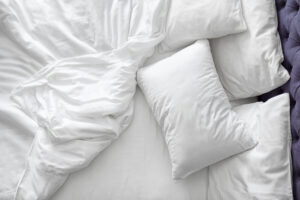Best Linen Sheets
Learn how linen is made, its benefits, the best linen sheets on the market, and how to care for linen bed sheets.
Disclosure: By clicking on the product links in this article, Mattress Nerd may receive a commission fee at no cost to you, the reader. Read full disclosure statement.
What are Linen Sheets?
Linen is a classic fabric with an old-world feel and a rumpled texture, and when sheets are made from it, they provide natural cooling, wonderful night’s sleep. But not all linen sheets are created equal, so it’s important to learn how to distinguish between high and low-quality sets. In this guide, we’re covering how linen is made, its beneficial qualities when used in bedding, the best linen sheets on the market, and how to clean linen.
Disclosure: By clicking on the product links in this article, Mattress Nerd may receive a commission fee at no cost to you, the reader. Read full disclosure statement.
Best Linen Sheets on the Market
- Editor’s Pick – Parachute Linen Sheet Set
- Softest Linen Sheet Set – MagicLinen Natural Linen Sheet Set
- Most Color Options – Brooklinen Linen Sheets
- Best Organic Linen Sheets – Saatva Linen Sheets
- Best Value – Tuft & Needle Linen Sheets
Watch Our Video Review

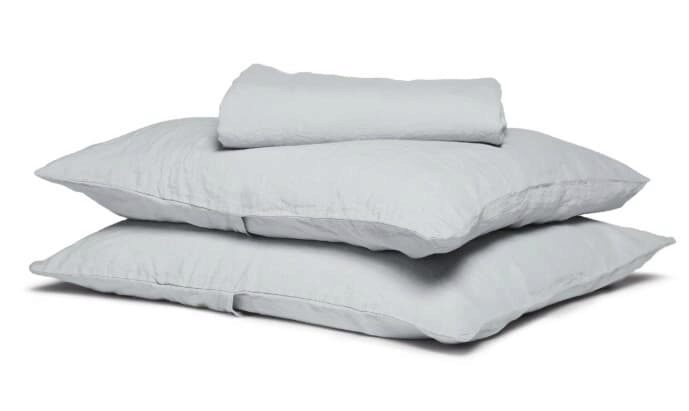
Parachute Linen Sheet Set
Editor’s Pick
Parachute products are crafted in northern Portugal by a family-owned business, and they’re Oeko-Tex certified, meaning no harmful dyes or chemicals are used. Parachute also doesn’t artificially soften its fabrics like some brands. Made from European flax, their linen bedding set comes in eight colors and six mattress sizes.
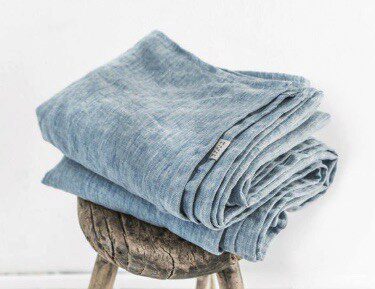
MagicLinen Natural Linen Sheet Set
Softest Set
MagicLinen sheets check all the boxes as they’re made from 100 percent European flax, are Oeko-Tex certified, and come in two depth options. What sets them apart is that they’re stone washed for a soft feel. Stone washing is a textile manufacturing process that gives newly made fabric a worn-in appearance while increasing its softness and flexibility.
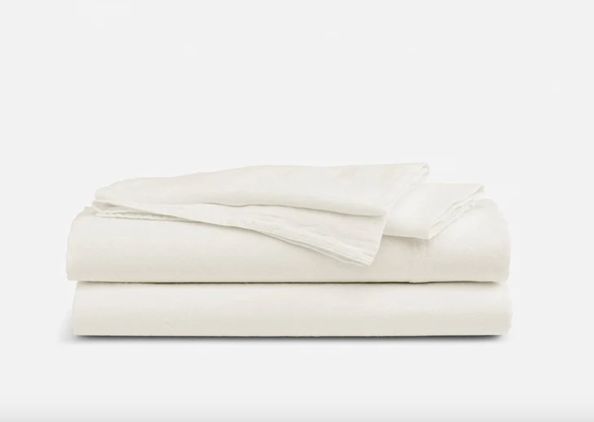
Brooklinen Linen Sheets
Most Color Options
The Brooklinen Washed Linen Sheets comes in eight color options, three of which are limited edition. You won’t have a problem matching these sheets to your current bedroom decor, and you also won’t have a problem getting comfortable underneath them. Made with soft, light European Flax, they keep you nice and cool during the summer and wonderfully warm during the winter.
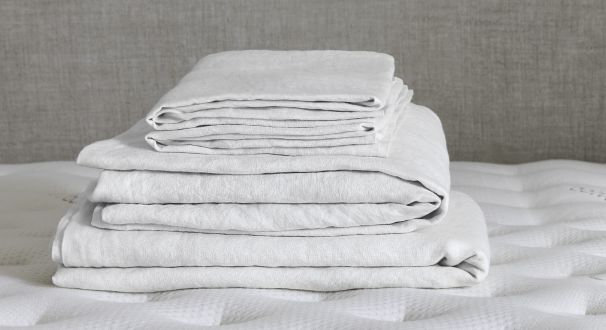
Saatva Linen Sheets
Best Organic Linen Sheets
Saatva’s Linen Sheets boast an OEKO-TEX Standard 100 certified construction, meaning you need not worry about toxic chemicals when snuggling up underneath them. And snuggle you will. These sheets have a luxuriously soft feel that will make you want to stay in bed long after your alarm goes off.
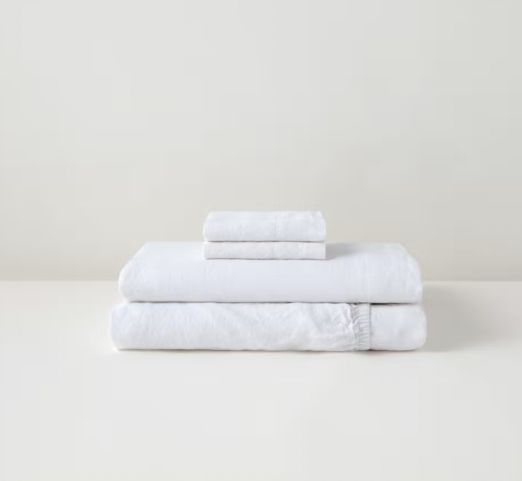
Tuft & Needle Linen Sheet Set
Best Value
Good value doesn’t mean cheap, rather it means that you’ll be getting a lot of bang for your buck. The Tuft & Needle Linen Sheet Set comes in at a pretty steep $260 (for Queen), but we think this product is well worth the cost. They’re incredibly sturdy and can maintain their softness for many years. Plus, these sheets have impressive temperature regulating abilities.
How Linen is Made
Linen is made from the natural fibers derived from the flax plant. It was originally discovered more than 8,000 years ago, and generation after generation of people all over the world have enjoyed its unique qualities. It’s known as one of the world’s strongest natural fibers and, from sheets to pants, suits, table cloths, drapes, dish towels, and even rugs, has many practical applications today.
While a handful of countries have environments that can successfully grow the flax plant, Belgium and France are known for producing the highest quality linen. This is because the local manufacturers faithfully follow to the lengthy, weeks-long process required to create linen in its strongest form. This is also why genuine Belgian Linen is more expensive; it’s made entirely in Europe from plant to linen rather than sourced from Europe and manufactured elsewhere, like India or China.
Flax is a temperamental crop, and from the hand-picking of the fibers off of the stalk to the perfecting process of the linen fiber, going from plant to product is laborious and expensive. Once the flax plant is ready for harvesting, the plant is uprooted. Then, it’s put through weeks of retting and other processes that remove impurities like oil, dust, and bran from the stalk. This readies the flax for spinning at the mill, where it’s transformed into yarn in a variety of thicknesses, looks, and weights. Finally, the yarn is tightly woven into fabric sheets.
If any part of this process is skipped, the look and functionality of the linen is negatively impacted.
Linen’s Unique Qualities
When deciding whether to purchase linen bedding for your room, take a cue from your closet. If you enjoy wearing linen, you’ll probably like sleeping on it. This fabric has a European charm that provides a tousled, slept-in look to any bedroom. In addition to its pretty aesthetic, linen has many other qualities that make it an attractive choice.
It has an airy feel to it, which is why linen tops and pants have become summer wardrobe staples. Linen sheets leverage the same breathable quality for your sleep to keep you cool throughout the night. If breathability is an important feature for you, consider checking out our best cooling sheets as well.
Linen also has a high moisture absorbency and will wick away perspiration in the warm months while insulating you in the cold months. It’s hypoallergenic and antimicrobial, and it has remarkable durability. Linen doesn’t shed or pill like other types of sheets, and high-quality sets can last for decades when properly cared for.
Another quality unique to linen is that it grows softer with time. While higher thread counts are generally associated with softer sheets, linen sheets in thread counts ranging from 50 to 150 can be exceptionally soft when made from high-quality yarn.
Why do Linen Sheets Wrinkle?
Natural questions tend to arise after discovering that the process for making linen is extensive and expensive. If linen’s so nice, then why does it wrinkle? It’s true, linen doesn’t like to stay smooth. Wrinkles happen more with some fabrics and less with others and, in linen’s case, it’s moisture-wicking properties are to blame.
Water is the wrinkle culprit in linen’s case. Polymers in the fabric are linked by hydrogen bonds, which are the same bonds that hold molecules of water together. Linen’s absorbent nature means that the water penetrates these polymer chains, which changes the shape of the fabric. Additionally, natural fibers like linen tend to wrinkle easily because they don’t have the artificial elastic properties of synthetic materials.
Ironing or steaming your sheets after washing is a great option to remove wrinkles, but those very wrinkles are part of the charm of linen bedding. The worn, lived-in look might grow on you with time.
How to Properly Clean Linen Sheets
If you’ve purchased your linen bedding from a high-quality manufacturer, each product should be labeled with washing instructions to guide you in how to best take care of the item.
In general, however, linen is simple to clean. When correctly manufactured, it never requires dry cleaning and can be hand- or machine-washed. We recommended washing linen bedding in lukewarm or cold water on a gentle cycle, as heat will weaken the fibers. Use a mild detergent or a biodegradable soap, like castile soap.
For the same reason, air drying is recommended to increase the longevity of linen sheets. If you’re eager to speed up the process, a few minutes (10-15) in the dryer on medium heat won’t damage the fibers and can help reorient them to their original shape. If you choose to place linen sheets in the dryer, put one sheet and one pillowcase in at at time with the pillowcase turned inside out. Overloading the dryer with the whole set will leave the edges over-dried and the center wet. If you choose to hang your linen, simply spread the clean bedding on a bed or hang on a drying rack. A gentle ceiling fan can help in the final stages of drying.
For stains, bleaches and detergents with color brighteners aren’t recommended as they may discolor or weaken the fabric. Try treating stains prior to washing by sprinkling baking soda, adding a few drops of vinegar, and then blotting the stain with a paper towel.
There’s no need to iron linen, but if you prefer a crisper feel than what your wash produces, a medium-heat setting is best. If you’re storing your linen bedding, fold it immediately and store in a cool, dry place. There’s no need for plastic bags or cardboard boxes, since linen naturally repels insects.

